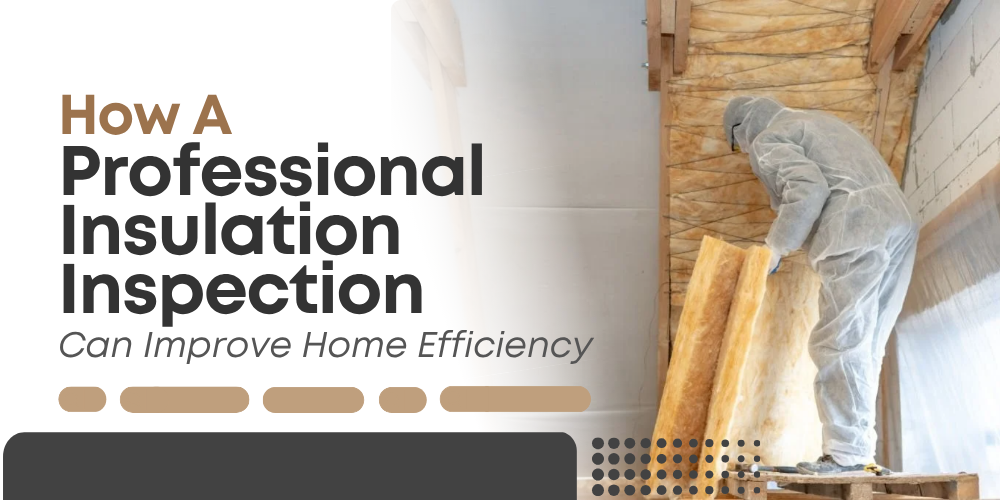How a Professional Insulation Inspection Can Improve Home Efficiency

Maintaining energy efficiency in your home isn't just about using LED bulbs or setting your thermostat correctly. One of the most overlooked yet impactful steps you can take is having a professional insulation inspection. This service evaluates the condition and performance of your home's insulation and ensures it's doing its job—keeping your heating and cooling inside where it belongs. Many homes, especially older ones, lose valuable energy simply because their insulation isn’t up to par.
Finds Gaps That Waste Energy
Professional insulation inspectors conduct inspections to uncover the hidden issues that cause significant heat loss or gain in your walls, ceilings, and attic. These weaknesses often go unnoticed until energy bills start to rise or indoor comfort starts to drop.
To prevent that waste, inspections pinpoint critical gaps and insulation failures in areas such as the following:
-
Exterior walls: Spaces between studs or poorly filled cavities allow heat to escape in winter and enter during summer.
-
Attic corners and edges: These areas are often overlooked during installation, leading to inconsistent coverage.
-
Behind electrical outlets or plumbing: Small gaps around outlets or pipes can lead to noticeable drafts.
-
Basement rim joists: Frequently under-insulated; these are common weak points for heat loss.
A professional insulation inspection helps reduce heat transfer and maintain a stable indoor temperature by identifying and addressing these spots.
Evaluates Attic Insulation Performance
Homeowners rarely check their attics unless they spot a visible issue, even though attics significantly regulate a home’s temperature. Most homeowners aren’t aware of how much attic insulation contributes to overall efficiency. A professional insulation inspection includes a detailed review of attic conditions to assess if insulation is still doing its job.
Inspectors evaluate the attic insulation based on the following:
-
Depth and R-value: Ensuring your insulation meets recommended levels for your region to resist heat flow effectively.
-
Material condition: Identifying signs of settling, moisture damage, or pest activity that may reduce insulation performance.
-
Even coverage: Look for gaps, thin spots, or compressed areas that allow heat transfer.
Assess Airflow and Moisture Risks
Insulation issues aren't just about temperature. Improper or damaged insulation can trap moisture and cause poor airflow, leading to even bigger problems. Mold, mildew, wood rot, and structural weakening can all stem from unchecked humidity and inadequate ventilation.
A professional insulation inspection addresses these risks through the following:
-
Airflow evaluation: Ensures insulation isn’t blocking critical ventilation paths, such as soffit and ridge vents.
-
Moisture detection: This method identifies signs of condensation, damp insulation, or discoloration that indicate water intrusion or air leaks.
-
Humidity balance: Reviews attic and crawl space conditions to ensure airflow supports a dry, stable environment.
By addressing airflow and moisture risks during an inspection, homeowners can avoid future repairs and protect their homes' structural health.
Supports Energy Efficiency Upgrades
After identifying insulation weaknesses, many homeowners wonder what comes next. That’s where the value of a professional insulation inspection truly shines. The findings from this process help guide smart decisions about upgrades and improvements, especially if you're considering energy-efficient renovations.
Here’s how insulation inspections lead to better energy-saving investments:
-
Targeted upgrades: Inspectors can recommend focused improvements in problem areas instead of replacing insulation throughout the home.
-
Material selection: Get expert advice on which types of insulation—blown-in, batt, or spray foam—will work best for each location.
-
Improved air sealing strategies: Combine insulation improvements with air sealing techniques to maximize thermal performance.
-
Rebate and incentive alignment: Many energy efficiency programs offer rebates, and having inspection documentation helps qualify for them.
Helps Lower Monthly Utility Costs
Reducing your heating and cooling costs starts with fixing the gaps and failures in your insulation system. A professional insulation inspection enhances the performance of your home's thermal envelope, directly lowering energy consumption.
Here’s how an insulation inspection helps reduce ongoing costs:
-
Better temperature control: Eliminating drafts and cold spots leads to consistent comfort, reducing the need for space heaters or extra AC use.
-
Less HVAC strain: A well-insulated home helps your furnace and AC run more efficiently, reducing wear and extending lifespan.
-
Seasonal savings: Inspections prepare your home to handle summer heat and winter chill without overloading your energy budget.
-
Cumulative impact: Even minor fixes—like sealing attic penetrations or adding insulation in neglected spaces—can lead to noticeable monthly savings over time.
An inspection becomes a proactive way to manage energy costs and equipment durability by addressing inefficiencies before they worsen.
A Smarter Home Starts with an Inspection
In conclusion, controlling your home’s energy performance doesn’t require a massive renovation. It often begins with a professional insulation inspection in Chester County. This simple, cost-effective step helps you uncover the causes of energy waste, pinpoint areas that need improvement, and plan targeted solutions that make your home more efficient and comfortable.
If your energy bills have climbed or your home has comfort issues, it’s time to act. Book a professional insulation inspection today to start making smarter energy choices and create a home that works better for you year-round.
- Art
- Causes
- Crafts
- Dance
- Drinks
- Film
- Fitness
- Food
- Spellen
- Gardening
- Health
- Home
- Literature
- Music
- Networking
- Other
- Party
- Religion
- Shopping
- Sports
- Theater
- Wellness
